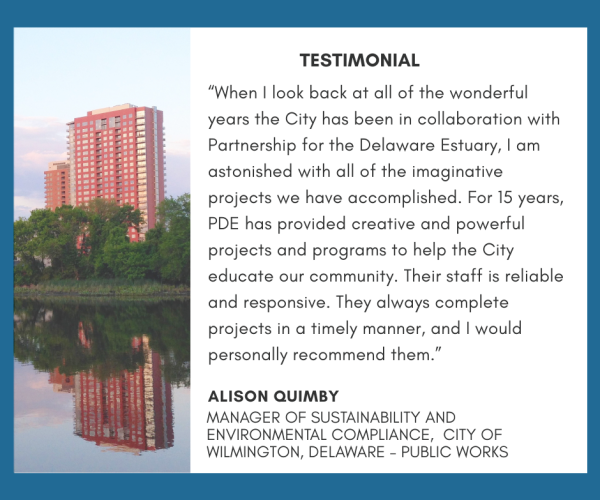What is Stormwater?
The United States Environmental Protection Agency (EPA) considers stormwater pollution to be the leading source of water pollution in the country.
Stormwater runoff occurs when water from rain or melted snow flows over the ground. Surfaces like streets, parking lots, and roofs prevent this water from soaking into the ground naturally. As it flows over the land, stormwater can pick up oil, road salt, and other pollutants before eventually flowing into rivers, lakes, or wetlands.
Some communities have combined sewer overflow systems, which exacerbate the problem. Improperly managed stormwater pollution can harm humans and the ecosystems that support life.

Image Credit: Philadelphia Water Department
PDE Municipal Stormwater Assistance Program
Partnership for the Delaware Estuary (PDE) is an environmental nonprofit organization with more than 28 years of experience in addressing clean water issues. Our team of engagement professionals can help you tackle your municipality’s stormwater issues and positively impact your community’s water quality, and that of the Delaware River and Bay. Working together, we can develop and provide high-quality outreach materials, training, and programs that support your community’s needs and permit compliance.
PDE can provide you with successful engagement programs to meet your MS4 goals. Activities and topics could include:
• Developing and installing interpretive panels and signs for best management practice (BMP) demonstration sites and general stormwater pollution prevention education.
• Administering storm drain marking programs designed to educate residents about the importance of keeping pollutants from entering storm drains.
• Coordinating hands-on volunteer opportunities like community clean-ups that engage residents in conservation actions.
• Hosting workshops and programs to educate the public and enable them to take action at home to positively affect water quality and stormwater runoff.
• Installing native plant pollinator gardens to improve habitat for local wildlife.
• Conducting dog waste reduction outreach campaigns encouraging proper disposal to improve communities and help reduce harmful bacteria from entering waterways.
• Leading environmental art contests that engage community members in the importance of clean water, stormwater management, and litter prevention.
• Providing ‘No Dumping! Drains to River’ storm drain medallions for $2 each, plus the cost of shipping.
Have something else in mind? Collaborate with PDE on your creative MS4 community outreach ideas, and we can make it a reality
What’s the Cost?
Activity costs are scalable from $12,000 to $150,000 annually. Learn how our programs can engage your residents and help you meet your community’s unique stormwater and MS4 needs by contacting jharrod@delawareestuary.org to discuss program availability, scheduling, and a budget that meets your needs.
The Partnership for the Delaware Estuary is a 501(c)(3) nonprofit organization. Our federal tax ID number is
51-0375307.
